Lawn: Insects, Weeds, Diseases, plus Benefits of a Healthy Lawn
Common Insect Problems
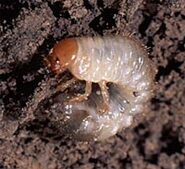
GRUBS: White grubs are the larvae of several kinds of beetles: Japanese Beetles, June Beetles and Northern Masked Chafer. All have creamy bodies with yellow to brown heads. Mature grubs vary from 0.25 to 1.5 inches in length depending on the species. Evidence of white grub damage includes wilted, dead or dying turf visible during Spring and Fall. The turf feels spongy under foot and can easily be pulled back like a carpet. Infested sites are often torn up by skunks, raccoons or birds feeding on the grubs.
Grubs feed on turf roots twice per year. They begin feeding following egg hatch in early fall then they burrow deeper in the soil for winter. In the spring, the grubs work back up in the soil to feed on the root system again before reaching maturity. Because Japanese Beetle eggs need moisture to hatch, excessive rain can cause widespread grub problems.
Grub damage can appear suddenly. If you see brown areas in your lawn and the turf picks up like carpet, contact our office immediately and we will devise a grub control option for you. Sufficient water (optimally 1/2 inch) from irrigation or rainfall should follow grub control application to move the material down into the soil where the grubs are feeding.
Grubs feed on turf roots twice per year. They begin feeding following egg hatch in early fall then they burrow deeper in the soil for winter. In the spring, the grubs work back up in the soil to feed on the root system again before reaching maturity. Because Japanese Beetle eggs need moisture to hatch, excessive rain can cause widespread grub problems.
Grub damage can appear suddenly. If you see brown areas in your lawn and the turf picks up like carpet, contact our office immediately and we will devise a grub control option for you. Sufficient water (optimally 1/2 inch) from irrigation or rainfall should follow grub control application to move the material down into the soil where the grubs are feeding.
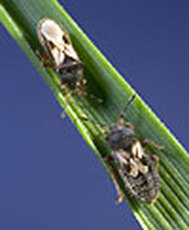
CHINCH BUGS: Adults are 3/16 inches long with a black body covered by fully developed white wings with 2 black spots. Their legs are red. Nymphs are much smaller than the adults and are orange-red with a white band across their back. They darken in color as they mature. Chinch bugs prefer hot, sunny and dry areas and overwinter as adults in thatch, leaf litter and other debris. They destroy grasses by feeding on the plant juices in the stems and leaves.
Damage may be visible from late June through August when the mature summer generation nymphs and adults are feeding. Summer females can lay eggs and a second generation of nymphs can mature from the end of August to September. Oftentimes, adults and nymphs can be seen walking on sidewalks or crawling up sides of light colored buildings. Damage first appears as irregular patches of drought stricken turf usually near sidewalks or driveways. Heavy infestations may completely kill the grass. Chinch bugs can move across an entire lawn in several days.
Damage may be visible from late June through August when the mature summer generation nymphs and adults are feeding. Summer females can lay eggs and a second generation of nymphs can mature from the end of August to September. Oftentimes, adults and nymphs can be seen walking on sidewalks or crawling up sides of light colored buildings. Damage first appears as irregular patches of drought stricken turf usually near sidewalks or driveways. Heavy infestations may completely kill the grass. Chinch bugs can move across an entire lawn in several days.
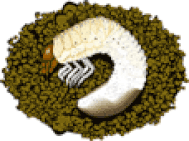
SOD WEBWORMS: are the larvae of the buff colored lawn moth. The larvae are from 2/3 to 3/4 inch long when full grown. They have a dark head and most are hairy with two dark spots on each body segment. The adults are small, whitish moths that fold their wings closely about the body when at rest. Adult moths hide in shrubbery or other sheltered spots during the day. Females fly over grass in the early evening and scatter eggs on the grass. Moth flights may occur May thru October. The worms live in a protective silken web and work only at night. As the larvae grow, they build silk-lined tubes close to the surface of the soil.
Damage appears as brown saucer shaped patches of grass in the hottest and driest areas of the lawn. The patches may expand to form irregular areas. Grass blades are chewed off at the soil level and silky white tubes are found nestled in the root area. The adults can be seen flying erratically above the grass in the evening hours.
If you feel you have a problem with any of these insects, please contact our office and we will send a lawn specialist to your property to diagnose the problem.
Damage appears as brown saucer shaped patches of grass in the hottest and driest areas of the lawn. The patches may expand to form irregular areas. Grass blades are chewed off at the soil level and silky white tubes are found nestled in the root area. The adults can be seen flying erratically above the grass in the evening hours.
If you feel you have a problem with any of these insects, please contact our office and we will send a lawn specialist to your property to diagnose the problem.
Common Weed Problems
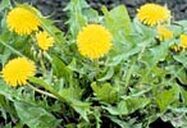
DANDELIONS: Most people recognizes the bright yellow flowers of dandelions. Dandelions appear in early spring and are followed by puffy seed heads. The stems are leafless and grow in varying lengths from the center of a rosette of long jagged leaves.
Dandelions emerge in early spring and begin flowering as early as April. They continue to bloom through summer and fall. Plants can reproduce from both seed and from the long taproot. Seeds can germinate at any time throughout the growing season.
Dandelions emerge in early spring and begin flowering as early as April. They continue to bloom through summer and fall. Plants can reproduce from both seed and from the long taproot. Seeds can germinate at any time throughout the growing season.
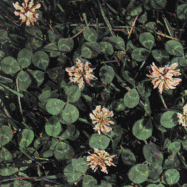
WHITE CLOVER: clover is characterized by its three part leaves and white pom-pom shaped blossoms. Clover is a low growing plant with creeping stems that root at the nodes. The leaves are dark green with a white crescent and grow in groups of 3. White clover emerges from dormancy in early spring and spreads by aggressive above and below ground stems. It also reproduces from seed.
Clover will continue to grow into the fall as long as moisture levels are adequate. During times of drought, clover will become dormant leaving unsightly brown patches in the lawn. Lawns that are mowed too short or under fertilized are more likely to have a problem with clover.
Clover will continue to grow into the fall as long as moisture levels are adequate. During times of drought, clover will become dormant leaving unsightly brown patches in the lawn. Lawns that are mowed too short or under fertilized are more likely to have a problem with clover.
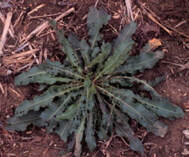
CURLY DOCK: is characterized by bright, shiny green, lance shaped leaves. The leaves are approximately 6"-8" long and 1"to 2" wide. The plant appears in spring and grows through the fall. In summer and fall the puckered wavy leaves are tinted reddish purple.
Small greenish flowers appear on a tall, narrow spike that rises from the center of the plant. Curly dock grows from a large brownish taproot. It is a perennial weed that grows most actively during hot dry weather.
Small greenish flowers appear on a tall, narrow spike that rises from the center of the plant. Curly dock grows from a large brownish taproot. It is a perennial weed that grows most actively during hot dry weather.
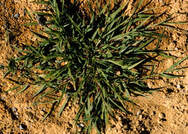
CRABGRASS: has an open or prostrate growth habit with coarse, light green blades. The most common form of crabgrass is hairy crabgrass which has fuzzy, rolled leaves. The seed head has three to nine branches fingers. Each finger can produce a hundred seeds. Crabgrass begins germinating once soil temperatures have reached 50 to 55F for ten or more days. Germination can take place over 6 weeks. Crabgrass grows best in the heat of mid-summer. It is not shade tolerant and grows best in full, hot sun. A healthy, lush lawn is the best defense against crabgrass. Healthy thick turf provides shade to the soil which inhibits crabgrass seed germination. Making sure mower height is adjusted also ensures that the soil is adequately shaded.
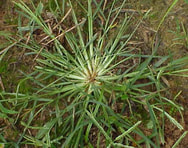
GOOSEGRASS: is a prostrate-growing summer annual. It grows in a clump with the base of the leaves being distinctively white to silver in color. Goosegrass germinates when soil temperatures reach 60 to 65F which is usually 2 weeks later than crabgrass. Like crabgrass, it requires moisture and light for germination, however, it is very competitive in compacted soil. Close mowing, frequent watering and heavily compacted soils enhance goosegrass competition. Core aeration can help break up soil compaction, and raising the mower deck can offer more shading at the soil line which inhibits germination.
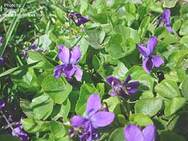
WILD VIOLET: is a winter perennial, growing 2-5 inches tall. It can have a tap root or a fibrous root system, and also can produce rooting stolons and rhizomes. The leaves can vary but usually are heart shaped, on long petioles with scalloped to shallow rounded margins. The flowers of wild violet range from white to blue to purple and appear from March to June. Wild violet flowers are pansy-like with three lower petals and two lateral petals on long single flower stalks. Violets grow in shady moist soil where most grass types will not grow. Wild Violets are classified as hard to control.
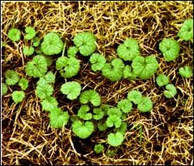
GROUND IVY: also called creeping Charlie, is a common lawn weed problem. Lawns in shaded areas and often with poorly drained fertile soil are typical sites for ground ivy to develop into a major problem. This plant may form extensive patches as it creeps along the soil and can move into sun areas. Stems are square. Leaves are arranged opposite of each other along stems, and are round to somewhat kidney shaped with rounded, toothed margins. Crushed leaves have a minty odor. Ground ivy has small funnel-shaped purplish-blue flowers appearing from April to June. Ground Ivy is classified as hard to control.
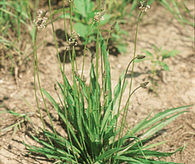
PLAINTAIN: There are several types of plantain the most common being buckhorn plantain and broadleaf plantain. Buckhorn plantain have tall stalks with "foxtails" at the tip growing from a rosette of elliptical leaves. Stalks grow 1-2' tall. Leaves are long, narrow, elliptical and slightly pointed. Ribs or veins are prominent. Buckhorn plantain grows April through July. Broadleaf plantain is characterized by low growing rosette of large, round, slight tapered leaves. The rosette of large oval leaves lies flat and tends to suffocate grasses. Seed stalks are 5" to 10" long and rise from the center of the rosette. Broadleaf plantain prefers damp rich soil and grows June through October.
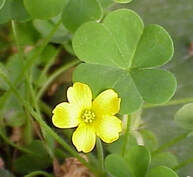
OXALIS: or yellow woodsorrel is characterized by three green heart-shaped leaves and small yellow flowers with 5 petals. Oxalis grows mid-spring to mid-fall in moist open sites though tolerates dry conditions once established.
Once the flowers mature, they turn into cylindrical seedpods that expel seeds forcefully when dry. The leaves of oxalis closely resemble that of clover, however, oxalis leaves have a distinct heart shape.
Once the flowers mature, they turn into cylindrical seedpods that expel seeds forcefully when dry. The leaves of oxalis closely resemble that of clover, however, oxalis leaves have a distinct heart shape.
Common Disease Problems
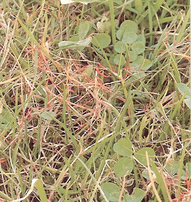
RED THREAD: shows up as circular or irregular shaped patches of rapidly dying grass during periods of cool moist weather. Small spots that appear water soaked enlarge quickly to cover a large part of the leaf. As the spots dry, the leaves fade to a light brown or tan. Later, the fungus forms thin reddish-pink finger-like structures at the tips of the grass blades giving the lawn a reddish tint. The patches may merge and grow larger as the disease spreads. Red Thread occurs most often during the spring and fall. Red Thread develops during prolonged periods of cool weather and high humidity when leaves are wet from dew, fog or frequent light irrigations. It develops best when grass is growing slowly from inadequate fertilization, lack of water, cool weather or other pest or environmental stresses.
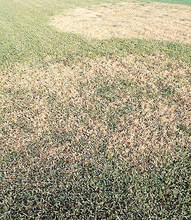
BROWN PATCH: shows up as large irregular circular areas up to several feet in diameter throughout the lawn. The patches usually have a brownish to gray discoloration with water soaked appearance around the edges. Brown patch usually occurs when temperatures are above 85F, the humidity is high, night temperatures are continuously above 60F and foliage remains moist for prolonged periods. Cool wet weather in late spring increases the severity of winter type brown patch. Poor drainage, lack of air movement, cloudy weather, dew, over watering and watering in late afternoon favor prolonged leaf wetness and increased disease severity. Excessive thatch, mowing when wet and leaf fraying by dull mower blades have also been shown to increase severity of the disease.
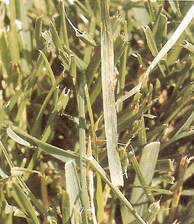
RUST: Early symptoms show up as small yellow flecks on the leaves and stems. The spots develop into orange or red pustules that rupture over time exposing and releasing masses of yellow, orange, red or dark brown spores. These spores can infect more tissue and plants until the infected turf takes on the color of the spores giving the lawn a rust colored tint especially noticeable from a distance. Anything moving through a severely infested area will be covered by the spores and my spread the disease. Occurs most frequently in Midsummer to fall. Moderately warm, moist weather and dew that lasts 10-12 hours promotes germination. Low light intensity, inadequate fertilization, drought stress and infrequent mowing are all contributing factors in the growth and spread of this disease.
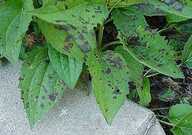
LEAF SPOT: The most obvious symptom of this disease is elongated circular spots on the grass blades. These spots have brown or straw colored center with black to purplish borders. Severely affected leaves may wither and die.
Cool moist conditions are most favorable for the growth of leaf spot. Spots first appear on grass located in shady areas of the lawn. Most commonly occurs during wet humid weather or in lawns that are often lightly sprinkled or mowed too closely.
Cool moist conditions are most favorable for the growth of leaf spot. Spots first appear on grass located in shady areas of the lawn. Most commonly occurs during wet humid weather or in lawns that are often lightly sprinkled or mowed too closely.